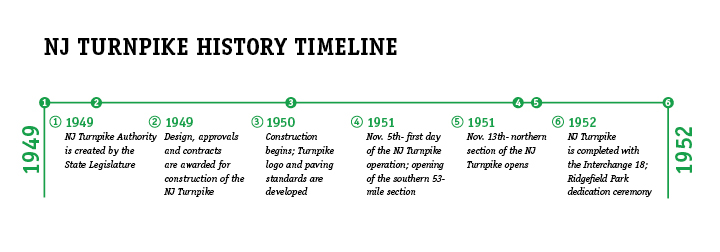
As post-WWII America started to mobilize and transportation along the Northeast corridor was greatly increasing, it became quickly evident that the New Jersey roadway system needed significant changes. As it turns out what it needed was some “inter”changes. The concept of the New Jersey Turnpike, a highway that would allow a motorist to drive from New York to Delaware at a smooth and constant speed, was born.
The project was an incredible challenge and would take every bit of expertise available to make it successful. Governor Alfred Driscoll started the wheels in motion with the proposal for the creation of the New Jersey Turnpike Authority in 1949. The idea was to create a self-funded roadway system, in which toll revenues amortize construction costs and pay for operation and maintenance. The initial construction of the massive project was funded by the sale of privately backed revenue bonds.
As originally constructed, the New Jersey Turnpike was a 118-mile direct route between the Delaware Memorial Bridge and Route 46 in Ridgefield Park, a direct link to the George Washington Bridge and New York City. Labeled the “roadway of the future,” construction began in January, 1950 employing many contracting firms to complete the various sections of the new roadway. The prospect of constructing a new highway across an already densely populated and busy state was ambitious. Opened to traffic in November, 1951, the Turnpike, truly a marvel of modern engineering, was built in only 21 months.
The New Jersey Turnpike was not only unique for its construction but also for the level of initiatives towards patron safety. It utilized innovations in technology to create new methods of communicating with drivers. Through changeable message signs and weather reporting stations, drivers were informed of current weather and road conditions. Planned rest stops, good maps and exceptional maintenance practices kept the Turnpike a model of safety and convenience for its patrons.
As the state and the use of the automobile grew, so did the Turnpike. Expanding by adding new interchanges, additional lanes, new corridors, improving safety features and even adding the convenience of E-ZPass, all contribute to the goal of providing a safe, steady transportation corridor from one end of the state to the other.



